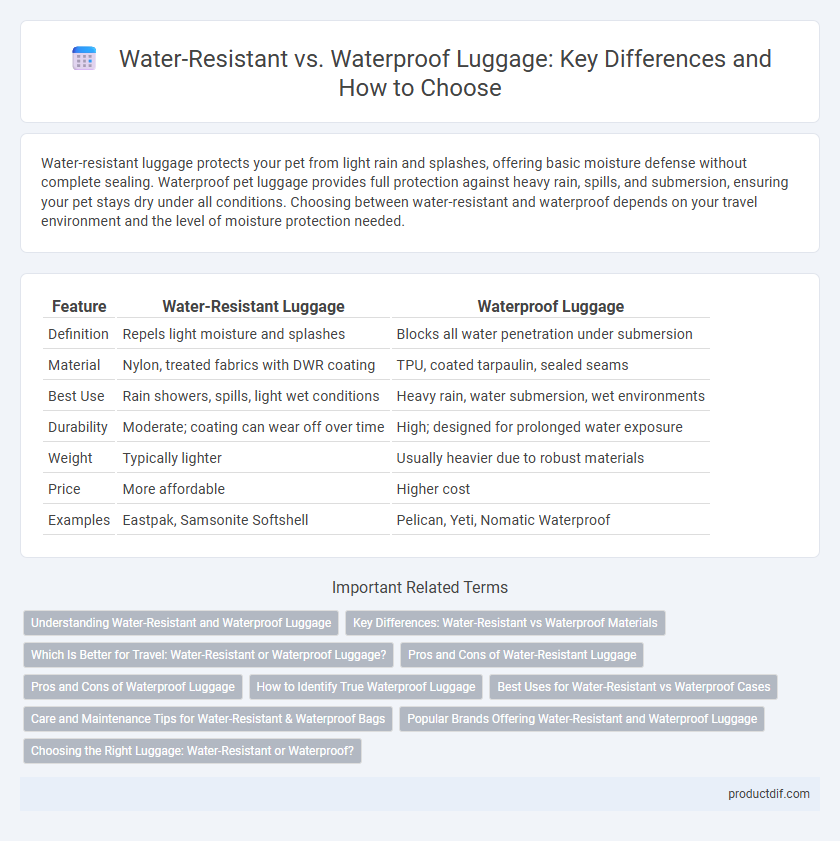Water-resistant luggage protects your pet from light rain and splashes, offering basic moisture defense without complete sealing. Waterproof pet luggage provides full protection against heavy rain, spills, and submersion, ensuring your pet stays dry under all conditions. Choosing between water-resistant and waterproof depends on your travel environment and the level of moisture protection needed.
Table of Comparison
| Feature | Water-Resistant Luggage | Waterproof Luggage |
|---|---|---|
| Definition | Repels light moisture and splashes | Blocks all water penetration under submersion |
| Material | Nylon, treated fabrics with DWR coating | TPU, coated tarpaulin, sealed seams |
| Best Use | Rain showers, spills, light wet conditions | Heavy rain, water submersion, wet environments |
| Durability | Moderate; coating can wear off over time | High; designed for prolonged water exposure |
| Weight | Typically lighter | Usually heavier due to robust materials |
| Price | More affordable | Higher cost |
| Examples | Eastpak, Samsonite Softshell | Pelican, Yeti, Nomatic Waterproof |
Understanding Water-Resistant and Waterproof Luggage
Water-resistant luggage offers protection against light rain and splashes by using materials that repel water but may allow moisture to seep in during heavy exposure. Waterproof luggage ensures complete protection from water ingress through sealed seams and waterproof zippers, making it ideal for harsh weather or wet conditions. Choosing between water-resistant and waterproof depends on travel needs, with waterproof designs providing superior durability and safeguarding belongings in extreme environments.
Key Differences: Water-Resistant vs Waterproof Materials
Water-resistant luggage materials, such as treated nylon or polyester, provide moderate protection against light rain and splashes by repelling water on the surface without completely blocking penetration. Waterproof materials, like PVC or TPU-coated fabrics, offer complete impermeability, preventing any water from entering even under heavy rain or submersion, ensuring contents remain dry. Key differences lie in the material composition, sealing methods, and intended usage scenarios, with waterproof luggage designed for extreme conditions and water-resistant options suitable for everyday travel protection.
Which Is Better for Travel: Water-Resistant or Waterproof Luggage?
Waterproof luggage offers superior protection against heavy rain and submersion, making it ideal for adventurous travelers and unpredictable weather conditions. Water-resistant luggage repels light moisture and splashes, which is sufficient for everyday urban travel or brief exposure to wet environments. Choosing between water-resistant and waterproof luggage depends on travel style, destination, and the level of water protection needed to safeguard belongings effectively.
Pros and Cons of Water-Resistant Luggage
Water-resistant luggage offers lightweight protection against light rain and splashes, making it ideal for everyday travel and short trips. Its materials are often more breathable and flexible, but they can allow water penetration during heavy rain or submersion, limiting full protection. Choosing water-resistant luggage balances convenience and moderate weather defense without the bulk and expense of fully waterproof options.
Pros and Cons of Waterproof Luggage
Waterproof luggage offers superior protection against rain, spills, and accidental submersion, ensuring contents remain completely dry in harsh weather or water exposure. The durable materials and sealed zippers prevent water penetration, ideal for outdoor adventures or travel in wet climates. However, waterproof luggage tends to be heavier, less breathable, and more expensive compared to water-resistant options, which might reduce portability and increase cost.
How to Identify True Waterproof Luggage
True waterproof luggage is identified by materials such as TPU-coated fabrics or laminated tarpaulin that seal out water completely, combined with welded seams instead of stitched ones to prevent leaks. Look for waterproof zippers or roll-top closures designed to create airtight seals, as standard zippers allow water penetration. Testing for genuine waterproof luggage involves checking manufacturer certifications like IPX ratings or submersion tests to ensure full water resistance beyond mere water repellency.
Best Uses for Water-Resistant vs Waterproof Cases
Water-resistant luggage is ideal for everyday travel, offering protection against light rain and splashes while maintaining lightweight convenience. Waterproof cases excel in extreme conditions such as heavy rain, water sports, or beach trips, providing full submersion protection and preventing water damage. Choosing between water-resistant and waterproof depends on your activity level and exposure to harsh environments, ensuring optimal luggage durability and content safety.
Care and Maintenance Tips for Water-Resistant & Waterproof Bags
Water-resistant luggage requires gentle cleaning with a damp cloth and mild soap to maintain its protective coating, avoiding harsh chemicals that may degrade water repellency. Waterproof bags benefit from thorough rinsing after exposure to saltwater or dirt, ensuring all zippers and seams are free of debris to preserve full waterproof functionality. Storing both types in a cool, dry place and regularly inspecting seals and fabric condition extends their durability and effectiveness against moisture.
Popular Brands Offering Water-Resistant and Waterproof Luggage
Samsonite and Tumi are renowned for offering water-resistant luggage that protects belongings from light rain and splashes, using durable coated fabrics and sealed zippers. For waterproof luggage, brands like Pelican and Nomatic provide hard-shell options with airtight seals and materials that prevent any water penetration, ideal for extreme weather conditions or water exposure. The choice between water-resistant and waterproof luggage depends on travel needs, with popular brands ensuring quality protection through advanced materials and construction techniques.
Choosing the Right Luggage: Water-Resistant or Waterproof?
Choosing the right luggage depends on your travel needs and exposure to elements; water-resistant luggage offers protection against light rain and splashes, while waterproof luggage ensures complete impermeability, ideal for heavy rain or accidental submersion. Material plays a crucial role, with water-resistant options often made from treated fabrics like nylon or polyester, and waterproof luggage featuring sealed seams and materials such as TPU or coated polycarbonate. For frequent travelers facing unpredictable weather, investing in waterproof luggage provides maximum durability and protection for belongings.
Water-resistant vs Waterproof Infographic

 productdif.com
productdif.com